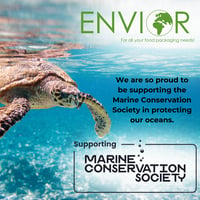🌿 Elevate Your Brand with Envior’s Bespoke Printed Packaging 🌿 At Envior, we offer a custom...
What’s the Difference Between Compostable, Biodegradable, and Recyclable Packaging?

In a world where sustainability matters more than ever, many businesses are making the switch to greener packaging. But with so many buzzwords flying around — compostable, biodegradable, recyclable — it’s easy to feel overwhelmed. What do they all mean? And more importantly, which is right for your business?
At Envior, we believe in making sustainability simple. Here’s a clear guide to help you understand the differences and choose the best eco-friendly packaging for your needs.
🌱 Compostable Packaging
What it means:
Compostable packaging is made from organic materials that break down completely into natural elements (like water, CO₂, and nutrient-rich compost) when processed in the right conditions.
Types of compostable materials:
-
Bagasse (sugarcane pulp)
-
PLA (a bioplastic made from cornstarch)
-
Kraft paper with compostable linings
How to dispose:
Compostable items should go into a commercial composting facility, or in some cases, a home compost bin (if labelled as "home compostable").
Best for:
Food containers, cups, clamshells, cutlery, and takeaway packaging where waste ends up with food scraps.
✅ Shop Envior’s compostable range → https://envior.co.uk/collections/compostable-cups
🍃 Biodegradable Packaging
What it means:
Biodegradable packaging will eventually break down into natural components — but there’s no timeframe or specific environmental conditions required. This means it might take months... or years.
Important note:
All compostable items are biodegradable, but not all biodegradable items are compostable.
How to dispose:
Most biodegradable packaging still needs to go to landfill unless it’s also recyclable or compostable.
Best for:
Situations where disposal options are limited, and plastic alternatives are needed. Always check if it’s certified to avoid greenwashing.
⚠️ Look out for misleading claims — "biodegradable" doesn’t always mean eco-friendly.
♻️ Recyclable Packaging
What it means:
Recyclable packaging can be processed and turned into new materials, reducing waste and conserving resources.
Examples include:
-
Cardboard pizza boxes (when clean)
-
Kraft paper bags
-
rPET plastic containers and lids
-
Aluminium trays
How to dispose:
Clean and sort materials into recycling bins — food contamination can make recyclable items non-recyclable.
Best for:
Dry goods, takeaway boxes, hot food containers, and businesses with reliable access to recycling facilities.
🌍 So, Which One Should You Choose?
The right option depends on your product, how your customers dispose of waste, and your sustainability goals.
| Packaging Type | Best for | Disposal Method |
|---|---|---|
| Compostable | Food-on-the-go, zero-waste cafés | Composting bin (commercial/home) |
| Biodegradable | Areas without recycling/composting | General waste |
| Recyclable | Clean, dry packaging | Curbside or industrial recycling |
✔️ At Envior, Sustainability is Built In
We’re proud to offer a carefully selected range of eco-friendly packaging that works for real businesses. From fully compostable food tubs to recyclable paper bags, our products are built for performance and responsibility.
📦 Browse our sustainable packaging collection now → https://envior.co.uk/collections
📩 Or get in touch for tailored advice on what’s right for your business. https://envior.co.uk/pages/contact
Envior – Simple, Sustainable, Smart Packaging.
Better for your business. Better for the planet.



